As the Apple Turns
by Bob Brooke
QUESTION:
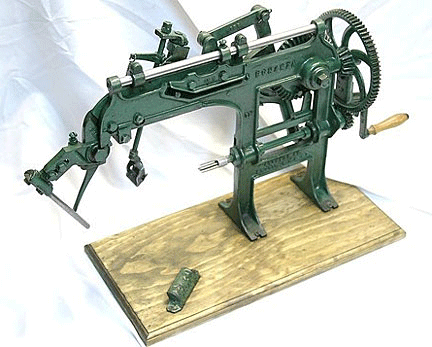 A
few months ago, my family set about cleaning out an old barn that
belonged to my grandfather. Boy, did we find some interesting stuff. We
can’t identify one of the items and wondered if you can help us. It’s a
machine type device with a crank and what seems like crab-like claws
hanging from some sort of gear system. Can you tell us what this is and
a bit about it if possible? A
few months ago, my family set about cleaning out an old barn that
belonged to my grandfather. Boy, did we find some interesting stuff. We
can’t identify one of the items and wondered if you can help us. It’s a
machine type device with a crank and what seems like crab-like claws
hanging from some sort of gear system. Can you tell us what this is and
a bit about it if possible?
Thanks,
Tom
__________________________________________________________
ANSWER:
I believe you’ve found what would have
been a treasure to the farm family that previously owned the barn.
Today, we don’t see machines like this anymore, but back in the second
half of the 19th century, they were commonplace. What you’ve found is a
commercially made apple paring machine, dating around 1880.
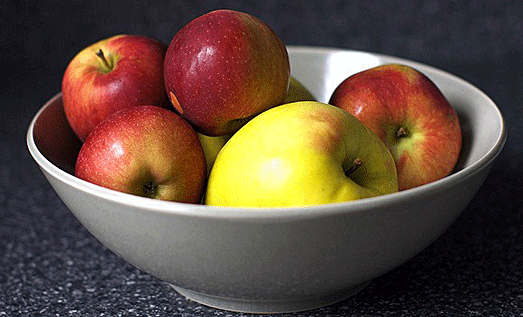
To paraphrase the opening line of one of America’s longest-running soap
operas, “As the apple turns, so do the days of our lives.” And so it was
for many people, especially farmers and their families, who relied on
the ordinary apple to quench their thirst in the form of cider and to
fill snacking and baking needs throughout the year. But before they
could do anything with their apples, they had to remove the skin. And
that’s where the lowly parer comes in.
The First Apple Parers
When the apple parer first appeared in England during the 1840s, it
caused much amusement. But it had been a staple of American life since
the late 17th century. Apples played a vital role in the diet of the
American Colonists. Fearful of drinking the local water, lest they
become ill, the Colonists took to making apple cider. Plus they dried
apples for use during the cold winters.
William Blaxton, a clergyman from Beacon Hill in Boston, Massachusetts,
planted the first apple orchard in 1635. Later he propagated a sweet
yellow apple which he dubbed Blaxton’s Yellow Sweeting.
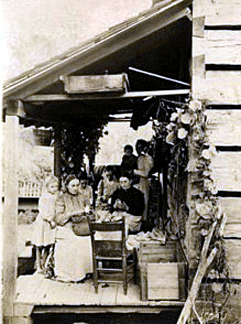 Colonists
picked apples in the fall, then pared, cored, and cut them into slices
which they strung on strong linen thread and hung to dry. They also made
applesauce, apple butter, and apple vinegar, all of which required the
apples to be pared and sliced. Colonists
picked apples in the fall, then pared, cored, and cut them into slices
which they strung on strong linen thread and hung to dry. They also made
applesauce, apple butter, and apple vinegar, all of which required the
apples to be pared and sliced.
To offset the drudgery of paring apples, they held “apple bees.” Members
of various farming communities gathered together, rotating from farm to
farm, to socialize and pare apples. According to the November 1859
Harper's Weekly, a popular pastime during such bees was for a young
woman to throw the string of apple paring over her shoulder where it
would form the initial of the name of her future husband when it hit the
ground.
But there was still the drudgery of paring apples until Yankee
inventiveness created a wide variety of paring machines. The first parer,
devised by 13-year-old Eli Whitney of later cotton gin fame, appeared in
1778. But it was Joseph Sterling of South Woodstock, Vermont, who came
up with a mechanical parer in 1781. In 1801, Thomas Blanchard, another
13-year-old, from Worcester County, Massachusetts, came up with his
version of an apple parer. Finally, Moses Coates of Downing’s Field,
Pennsylvania, obtained the first U.S. patent for an apple parer on
February 14, 1803.
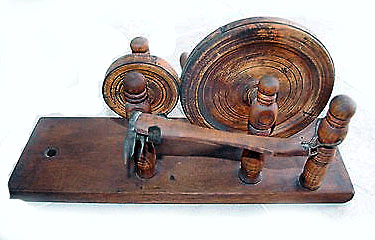 Whether
basic or complex in design, one thought was clear—pare the apple as
quickly and as efficiently as possible. Whether
basic or complex in design, one thought was clear—pare the apple as
quickly and as efficiently as possible.
The first parers were wooden and featured a shaft with a turning crank
on one end and a wood or metal fork on the other to hold the apple. The
operator turned the crank with one hand and guided, with the other hand,
a wooden handle with a mounted blade or knife, paring the apple.
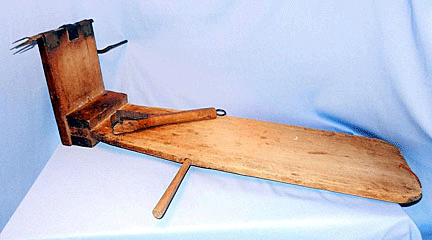 Farmers
made early parers by hand. They copied the devices of other farmers and
borrowed ideas from farm magazines to fashion their own devices. The
various types of early parers are amazing, including, to name a few, the
straddle board, table top, table mount, table mount gallows, floor
pedestal, leg strap, knee hold, and bench. Farmers
made early parers by hand. They copied the devices of other farmers and
borrowed ideas from farm magazines to fashion their own devices. The
various types of early parers are amazing, including, to name a few, the
straddle board, table top, table mount, table mount gallows, floor
pedestal, leg strap, knee hold, and bench.
As these primitive machines evolved, their makers speeded up the turning
of the fork holding the apple with the addition of cords, belts and
gears, and anchored the paring cutter in an upright post, although still
guided by hand, as in Coates’ parer.
It was inventor Ephraim C. Pratt who was credited with the first
practical parer with the blade being guided over the apple mechanically
with spring tension, leaving the operator a free hand to pull off the
pared apple and put on " a new one. Pratt’s parer allowed the knife to
vibrate and accommodate itself to any irregularity in the surface of the
apple.
Types of Apple Parers
Essentially, apple parers can be organized into five categories—Lathe,
Turntable, Arc or geared segment, and Return, quick or otherwise, as
well as the Commercial models added later on.
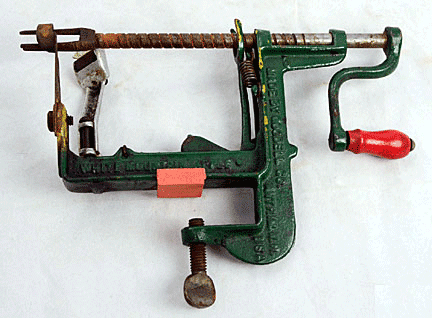 In
the most simple terms, lathe parers utilize a lathe with the apple and
the cutter moving past one another in a straight line. In most lathe
parers the parer arm can swivel to follow the con-tour of the apple but
it is in a fixed position on the frame. In
the most simple terms, lathe parers utilize a lathe with the apple and
the cutter moving past one another in a straight line. In most lathe
parers the parer arm can swivel to follow the con-tour of the apple but
it is in a fixed position on the frame.
The apple is propelled past the cutter on a fork on the end of the lathe
and is pared. There are some models, including the Bay State and Empire
State, in which the apple. stays in a fixed position and the paring
knife is propelled past the apple.
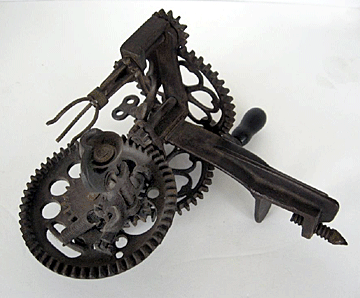 Turntables
are those parers with knifearms—mounted on a turntable—that make a
circle around the apple. The parer action begins with the knife in
position, the blade pressed against the apple by spring tension. As the
crank is turned the apple is rotated and the turntable makes a circle. Turntables
are those parers with knifearms—mounted on a turntable—that make a
circle around the apple. The parer action begins with the knife in
position, the blade pressed against the apple by spring tension. As the
crank is turned the apple is rotated and the turntable makes a circle.
There a few models in which the knife is stationary and the apple is
mounted on the turntable. Generally the paring takes place during the
first half of the circle, then a cam beneath the turntable lifts the
cutter off the apple and the turntable continues in the same direction
to the starting point. The pared apple is removed by hand and another
placed on the fork.
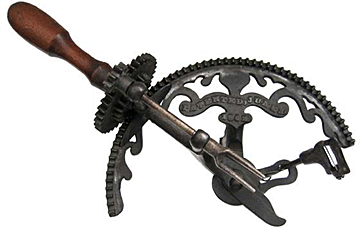 Turntables
include the Keys, Lockey Howland, various Goodell, Harbste Bros.,
Reading, Penn, Hudson, Rice Scott, Hunt, Sayre and Tripp Bros. models,
and the super rare Star and Climax. Turntables
include the Keys, Lockey Howland, various Goodell, Harbste Bros.,
Reading, Penn, Hudson, Rice Scott, Hunt, Sayre and Tripp Bros. models,
and the super rare Star and Climax.
The arc parer is deceptively simple—and very efficient. The action comes
from the gearing on the semicircle arc. Paring is accomplished with one
traverse of the stationary arc. Arc' models include the White, Pratt
Goodell's various Lightnings, and th rare Thompson.
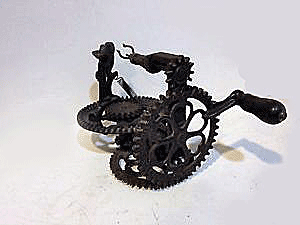 The
quick return parer is called such because the cutter, after paring the
apple in the first 1801 degrees, returns t the starting point—sometimes
with smart "snap." There are also dozens not-so-quick returns. These are
basic allthose parers with the paring knife mounted on a turntable with
the parin knife going around in a circle. The knife is geared away, or
reversed, from the Waverly. The
quick return parer is called such because the cutter, after paring the
apple in the first 1801 degrees, returns t the starting point—sometimes
with smart "snap." There are also dozens not-so-quick returns. These are
basic allthose parers with the paring knife mounted on a turntable with
the parin knife going around in a circle. The knife is geared away, or
reversed, from the Waverly.
Commercial parers were first introduced on the American market in the
1870s, with many of the models being made in the Rochester, N.Y., area.
Early models were hand: powered but electric motors came on the scene in
later years. Commercials include familiar parer manufacturing names such
as Goodell, Hunt, Scott and Tripp, along with Boutell, Buchi, Coons,
Hebbard . Pease and Williams.
Although the variety of gears and the intricate movement have always
appealed to collectors, it can be a challenge to collect apple parers.
While the more common lathes and turntables are still out there, turning
up consistently at antique shows and big flea markets for about $2.50 to
$45, there are some parers that hardly ever come up for sale, including
the Thompson, the Star and the Climax, so they’re usually priced
accordingly. For example, a Thompson went for $1,300 at auction and the
Climax by George Brokaw brought $4,800 in an auction duel.
<
Back to Readers Ask Archives
Next Article > |
